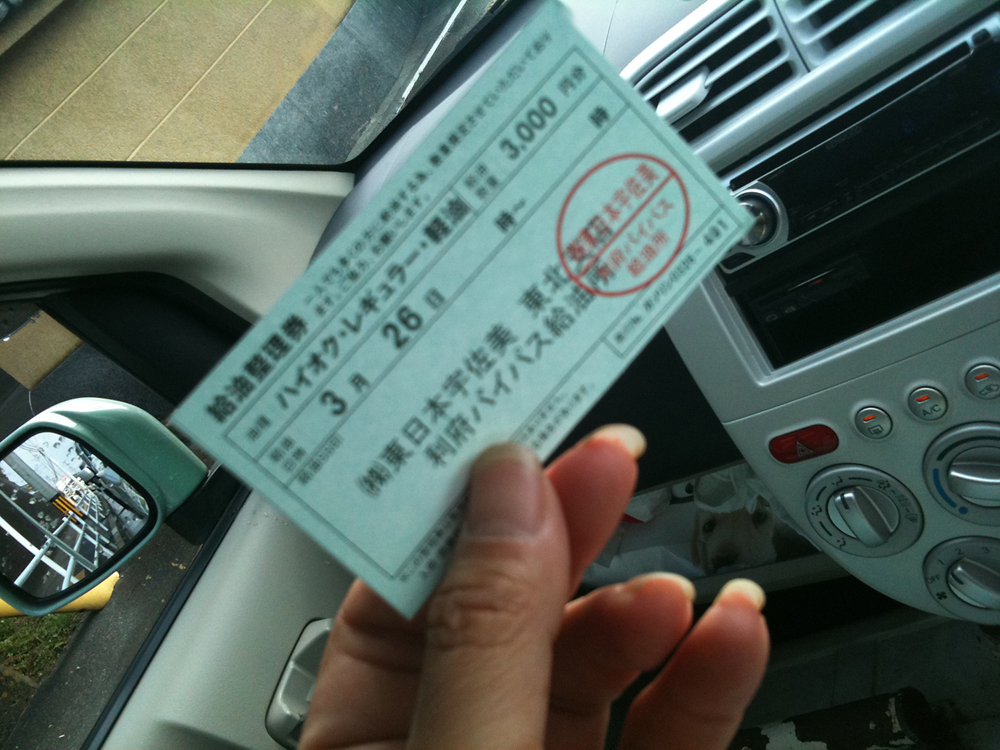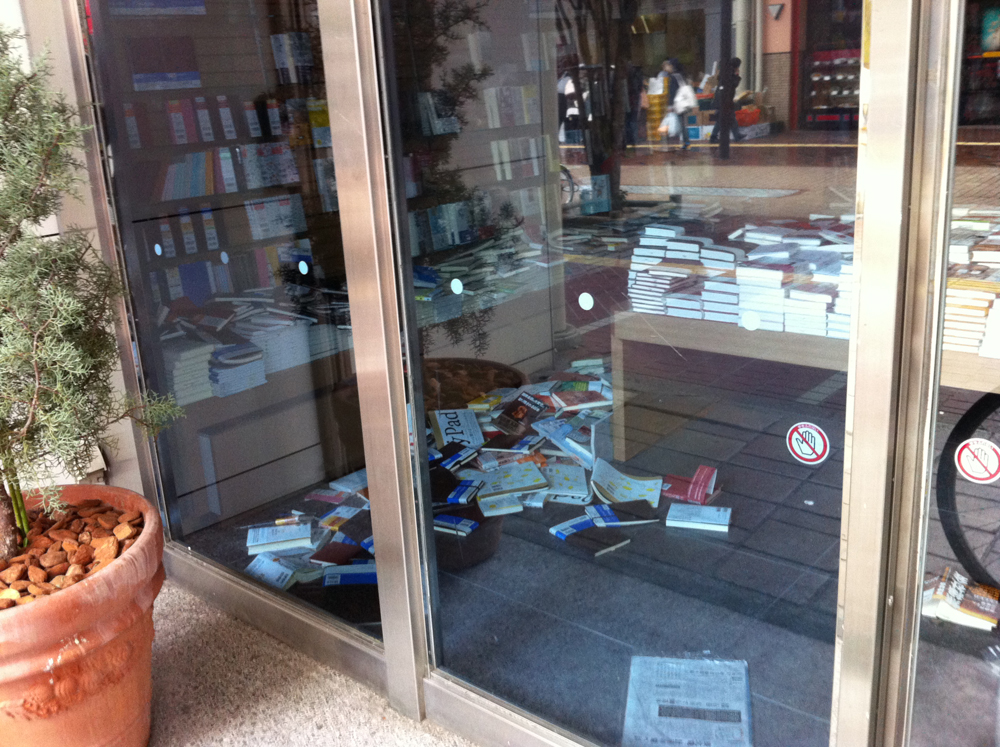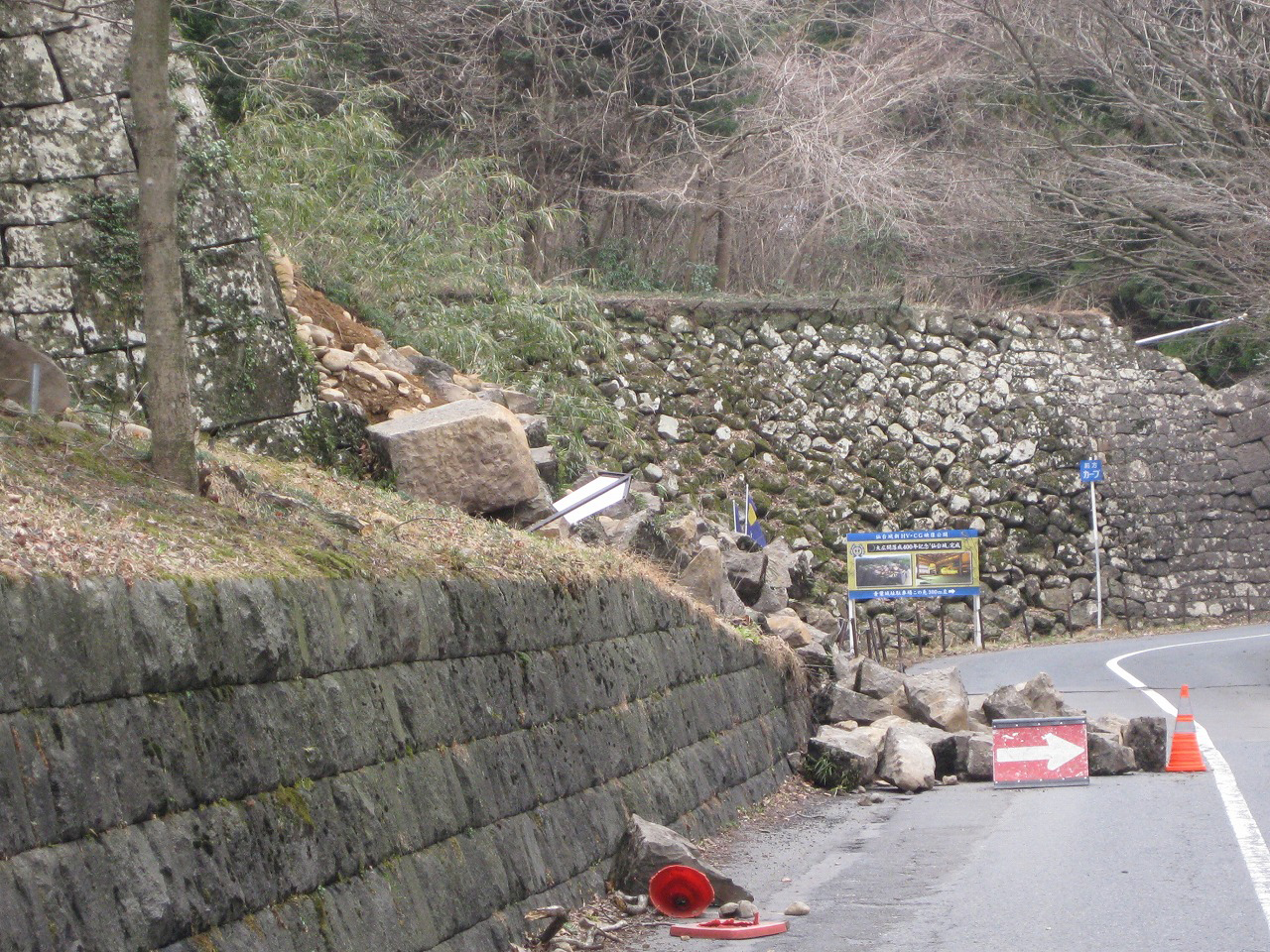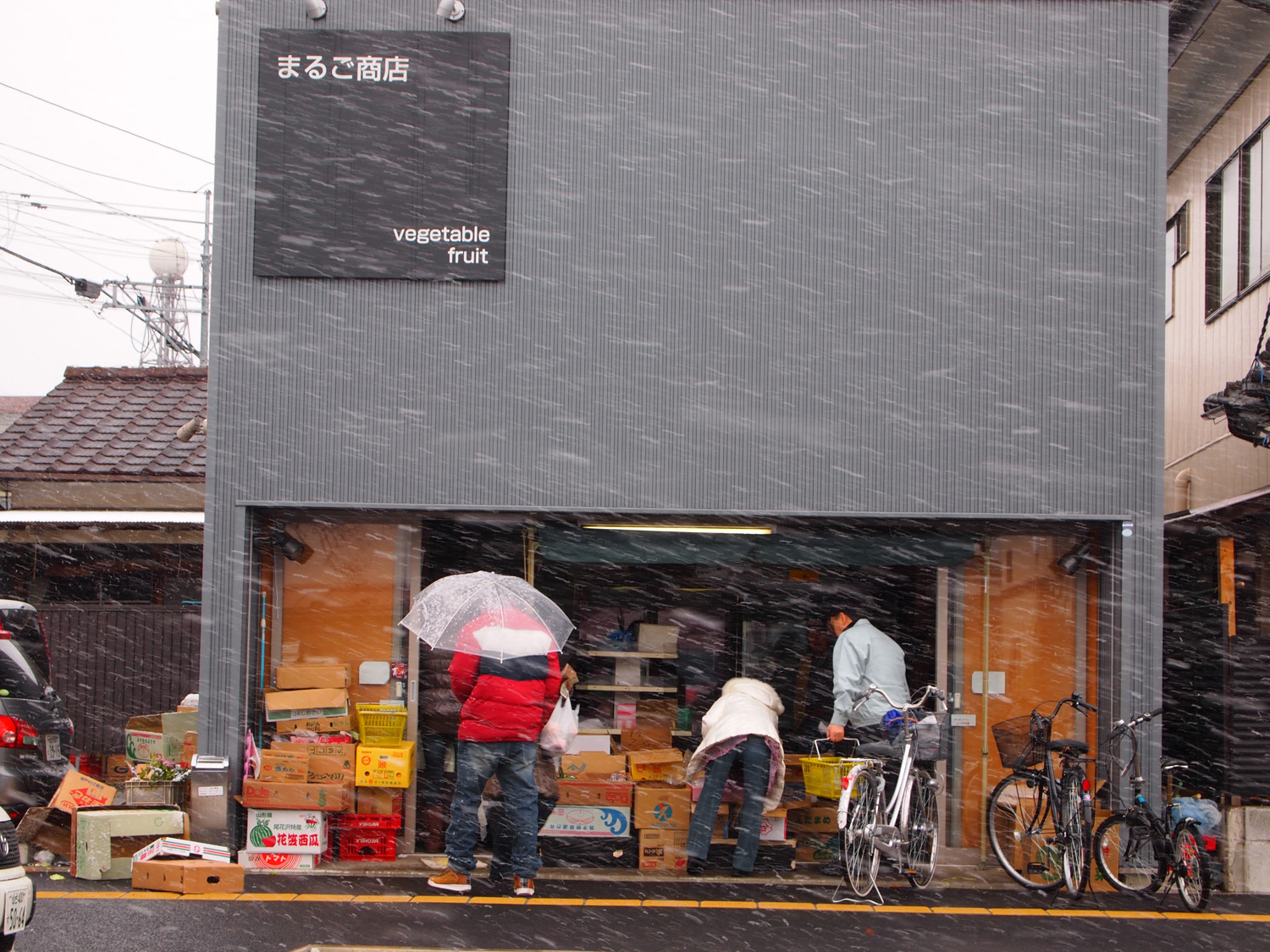There Was a Period of Time When I Had Quit. But Sometimes Now and Then I Still Take Pictures in the Same Places
March 11 Fixed-Point Observation Photo Archive Project Open Salon, at the Thinking Table on April 31, 2013
This article was translated by Chloe Brooks, Callysta Caraballo, Rebecca Diego, Kimberly Fenn, Jeremy Garvida, Wen Jiang, Sarina Katznelson, Miya Kewish, Sammie Kuriyama, Ting-Chieh Ou-Yang, Isabella Tinte, and Yuyang Zhang. This collaborative translation was part of an advanced Japanese language class at the University of Washington taught by Justin Jesty.
Narrator: Nahoko Nakayama
Interviewer: Masami Satō (20th Century Archive Sendai, NPO)
■ When the muddy water had receded after coming up to the top of the staircase in our house. (After this it flooded up to the 2nd floor again.)
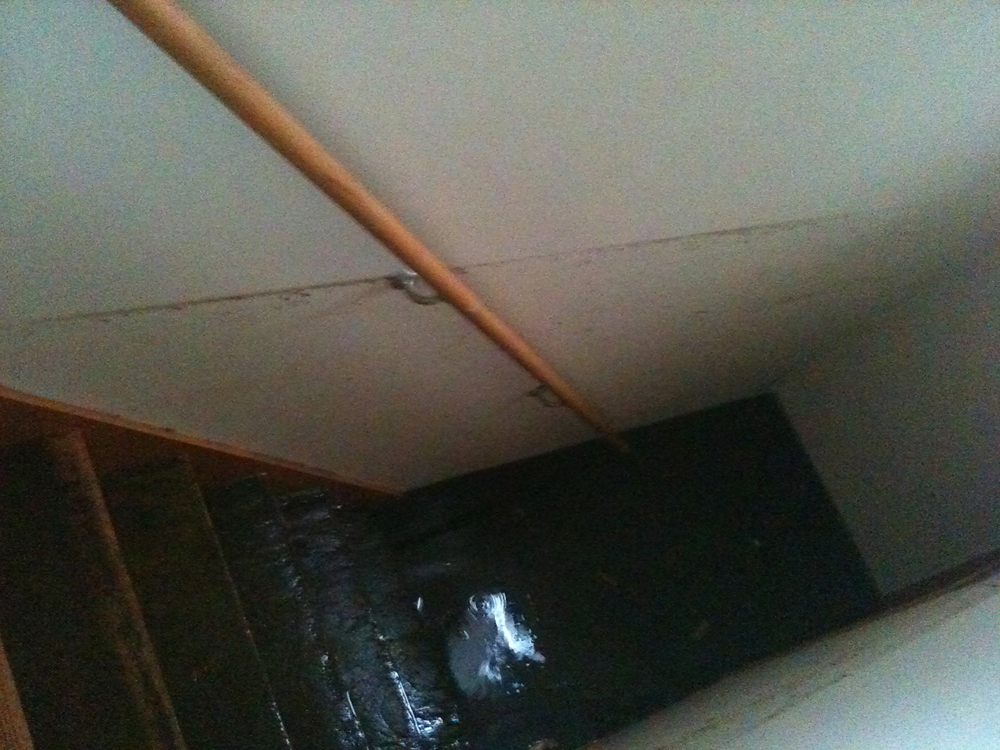
March 13, 2011, 16:05 The second floor at home in Tsukiyama, Ishinomaki, Miyagi Prefecture
[Nakayama:]
My name is Nakayama and I'm from Ishinomaki. The area of Ishinomaki where our house was on March 11th is about 200 meters away from what's known as Ishinomaki Industrial Port, where the big Nippon Paper factory is, at the foot of Mt. Hiyori. My family has four members: me, my husband who's a businessman, and an 11-month-old and a 5-year-old daughter. On the day of March 11 my husband was at work so when the earthquake struck at 2:46pm it was me and my two children. Because of the damage done by the tsunami, our house was totally destroyed and unlivable. For 4 months, we rotated our evacuation lives among our relative’s houses in Sendai-shi, Tomiya-machi, and Shiogama-shi. In the middle of August, we secured some temporary housing, where we lived for a year, but after that we made the decision to have the damage to our house repaired. Now it has been completely remodeled and the four of us live there together.
Since I was inside the house on the day of the earthquake, I couldn't hear any tsunami warnings at all, and because there was no electricity I had no information, so I was just watching out the window. I think it was around 3:15pm when the tsunami came rushing in, like a wave of black paint sloshing around. In about three seconds, before I even had time to count, it washed away our two cars parked in front of the house. As soon as we saw that happen we scrambled up to the second floor and got out of harm’s way. Then I was just staring down the stairwell at it for a long time thinking, "What am I going to do with all this water?" I took this photo at about 4:05 when it had temporarily receded. People often comment that it's amazing that I was taking photos like this. After thinking back over it a lot I think there was one reason I took it. It was a picture I took to show my husband how far the water had come up when he wasn’t at home. My husband isn't home much because of work, and because he doesn’t get to see most of the things like our kids’ events and their growing up with his own eyes, I have a habit of taking pictures and showing him when he gets home, like “look this is what we did today.” I think the habit kicked in at that time, so I took the one picture to have something to show without even feeling any fear.
■ They Finally Smiled
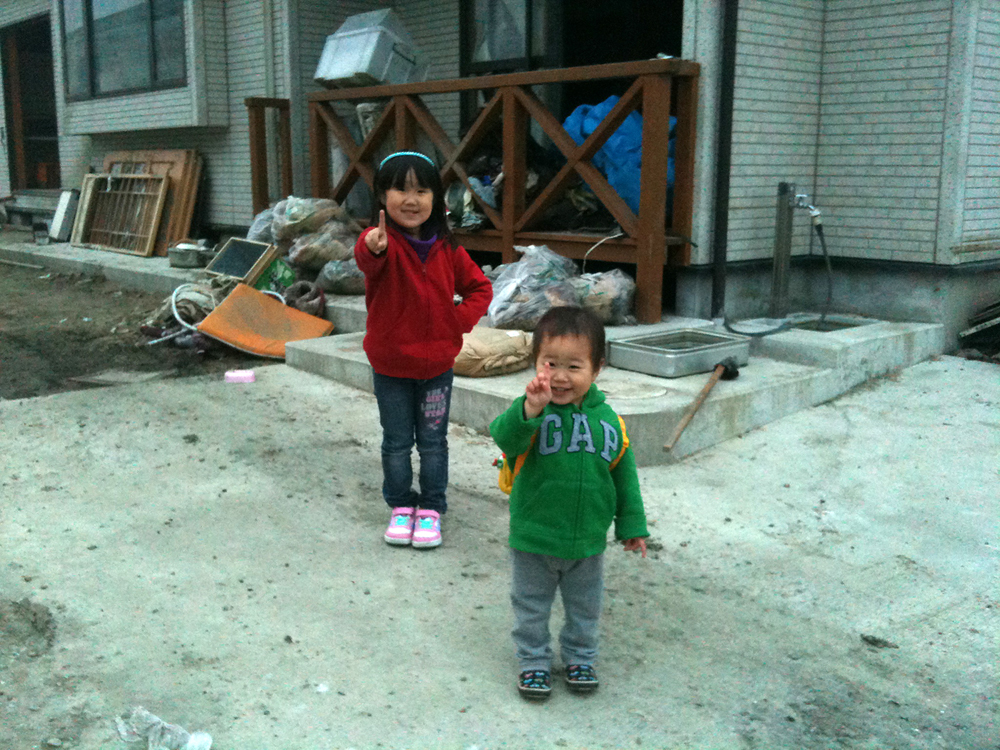
April 19, 2011, at home in Tsukiyama, Ishinomaki, Miyagi Prefecture
April 19 was around the time cars were finally able to access the neighborhood where our house is. The roads had been blocked by debris and it was a neighborhood where the water took a long time to recede. I recall that this was the first time we could take the car to go see our house as a family. If I explain why I took this photo, the kids look like they're smiling happily in it, but it actually took a long time to get to the point of that smile. The debris smelled bad. It was scary and made strange sounds when the wind blew. The house was shaky and everything was just dirty. As soon as we arrived at the house, the children started saying, “I don’t want to be back here, Mommy. Can't we go home already? I don’t like it here anymore, it smells bad, it’s scary,” and they started crying and fussing when we tried to clean up the debris, and wouldn't even let us clean up. But as the clean-up progressed and it got a little nicer they started saying "Mommy it's finally getting cleaner. It's so much better. I can see some of my old toys.” This picture is from when they finally started to smile again. The picture really embodies the feeling of relief that I had when I took it like, thank goodness they finally started smiling again.
■ The Children Riding Their Bicycles in the Now-Vacant Lots Near Our House.
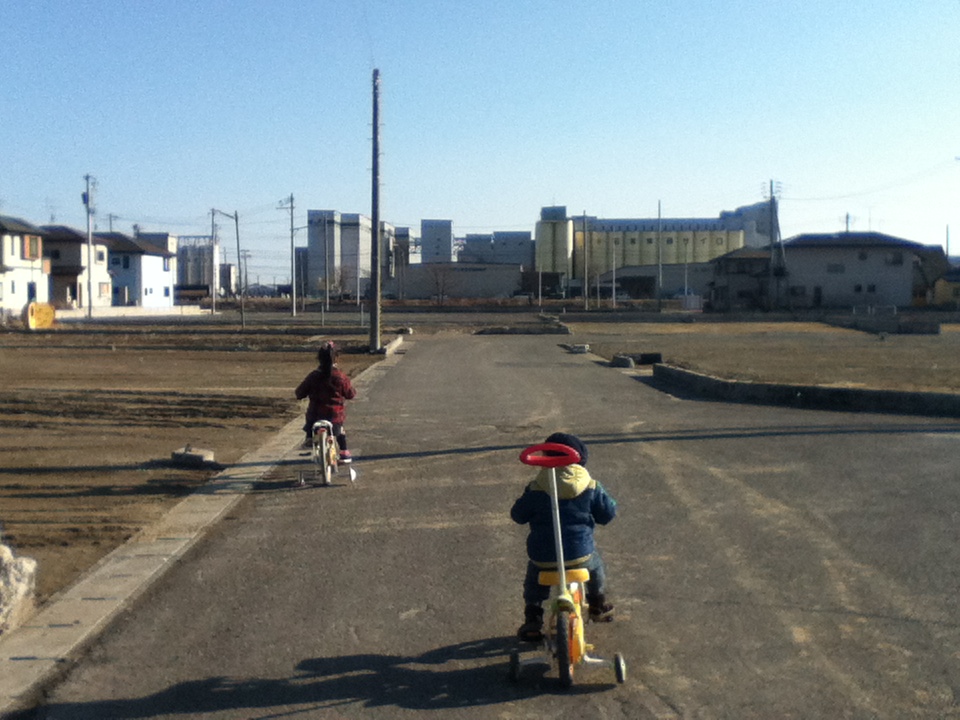
March 14, 2012, in Tsukiyama, Ishinomaki, Miyagi Prefecture
A lot of time has passed here: March 14th 2012. It was toward the end of January or February 2012 that we made the decision to fix our house. I think this is about one month after that. The tsunami was 2-3m deep in this area. There had been about 1000 houses around here, all reduced to vacant lots. Some houses built within the last 5-10 years had just about managed to stay standing without being destroyed. The landscape had really just become an expanse of empty lots. And even though we'd decided to fix the house and start living in it again, when we were there cleaning out the garbage, we'd get asked things like "When're you going to tear down your house?" Or, even after we'd taken so much trouble to clean things up, we'd arrive in the morning for another day of cleaning only to discover someone had dumped a bunch of debris nearby. Although we'd made the decision to move back in, there were times when I felt myself wavering. Even in the middle of this, we felt there was no other choice but to keep going, since it was something we'd settled on and since the financing was already coming together. So we put everything we had into fixing the house, as a husband and wife team.
While we were fixing up the house, we let the children play to fill the time. Because it was all vacant lots, I told them riding bicycles would be fun. It was all open so there was no one around to complain if they made a lot of noise. So I brought them to big open areas like this and let them ride their bicycles. I was looking at them from behind. As I was watching them I felt happy and I took the photo with the feeling that even in such a changed landscape children grow up so quickly.
[Satō:]
Thank you very much. In Nakayama-san's photographs, there are two photos among the five she's sharing with us today where children appear. Last year when the topic of how to take fixed point observation pictures came up, there was a conversation about whether children could be put in them, if their growth could be used as a fixed point for observation, and if that could be used as a form of expression. We selected these photos from Nakayama-san because they portray the passage of time and the way children grow up very clearly when you look at them like this.
■ I Fled With My Two Children Up to the Second Floor of Our House. The Tsunami as Seen From the Veranda.
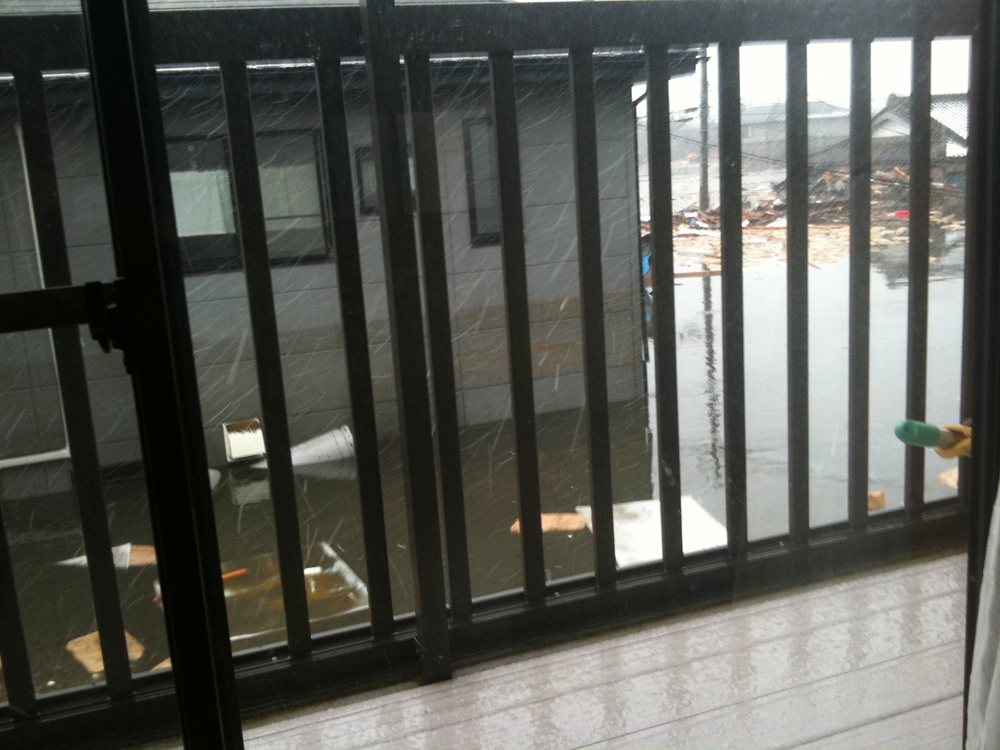
▼
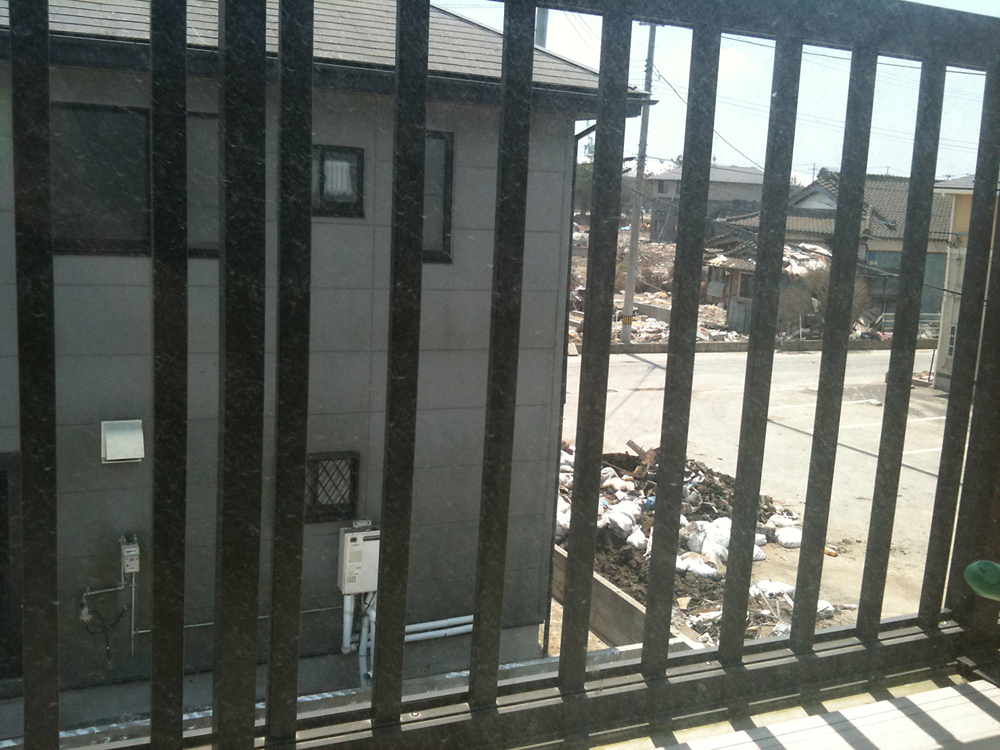
(above) March 13, 2011, 16:05 / (below) June 8, 2011
2nd floor at home in Tsukiyama, Ishinomaki, Miyagi Prefecture
[Nakayama:]
The top picture is one that was included in 3.11 Records of Memory. (Footnote 1) The tsunami came at about 4:05. This is a photo taken at about the same time as the first photo I took of the staircase. It was taken from the veranda of my house as you look in the direction of the sea. The bottom picture was taken from the same place three months later. I don't think I would have kept the photo from three months later myself, but after 3.11 Records of Memory came out the phrase "fixed point observation" started to circulate on Twitter, so I thought maybe I'd give it a shot. Since then I've taken a lot of pictures periodically from the same spot. It was just something I tried when the phrase “fixed point observation” appeared. But, the scenery doesn’t change at all. I actually wondered to myself while I was taking the pictures whether fixed point observation was necessary to me at all. I still feel that way. In the picture I showed before, that I took from behind the kids riding their bicycles, if I were to take the same picture from the same spot today the only thing that would be different would be that their training wheels are gone. Nothing else has changed. Even now, I sometimes think about whether or not fixed point observation is important for me. It would be great if everyone's neighborhood kept changing but I get a stronger impression that ours is just becoming more of a wasteland. There was a period of time that I stopped creating these records. But sometimes now and then I still take pictures in the same places.
And I put them up on Facebook and attach comments like "I took another one today. This is what things look like today. You can see things changing a little here." Since I've kept at it for a long time, tons of people have appeared who sympathize with me as a mother keeping up awareness of this place. Now that two or three years have passed, I get comments from other moms I know like, “You know, I’ve been taking photos from that spot too and you can see the change," or, “I tried it too!” Or sometimes--although this is about different spots--we compare pictures with each other, as mothers who have kept observing a certain place. In truth there are times I'd rather just forget.
There are times I don't want to see any more pictures and when fixed-point observation is painful. But then again, recently, I've been able to open up about "That day" and talk about it with others who have kept watching in this way. Although I don’t want to remember these things, having continued these fixed point observations, continuing to speak up, listening to everyone’s stories, what I’ve finally come to feel is that I ended up wanting to communicate these things to my children.
This is getting away from the topic of the photographs a little, but when I received 3.11 Records of Memory, And Today after it was published, I was overwhelmed with emotion, or rather, I felt something that I couldn't put into words. (Footnote 2) I called you up on the phone, Satō-san, and really troubled you about it. The first page I opened to was the Ishinomaki page and something I can’t put into words hit me. Thinking about it with some distance now, I think the reason I was so moved was that I'd gotten to that point without a spare moment to look back, and what I felt from the second volume of fixed point observation was that the people and town were amazing to have changed this much. That's a big part of why I have such a strong feeling of involvement with this project now. For me, since I’m raising kids now, a common theme among us mothers who are doing this kind of activity together is what we’ll pass on to our children and how. There were times that I thought fixed-point observation wasn’t something I needed in my life, that it was a burden. But I believe the fixed-point observation project really is something that can convey to our children the strength that people have, the changes happening in our towns, the power of people’s wisdom and courage, and the power of coming together. Pictures that even I thought were pretty meaningless, I now feel like I want to save forever to convey to our children who might wonder when they become adults, how we cleaned up all the debris since it'll all have been cleaned away.
[Satō:]
Thank you very much. I think that continuing to take photos and observing things from a fixed point post-March 11 is probably not something that will end in one or two years. If there are places where there’s change over the span of two years, there are also places that have not changed, like we heard in the talk just now, or even appear to be moving backwards. There are certainly times when people don’t want to look or don't want to take photos. But in 5, 10, 20, even 50 or 100 years when someone takes a photo--though obviously it won't be the same people taking the photos--it will be possible for the first time to assess the change. I’m looking forward to seeing how things will be in future.
(Footnote 1) A book published by the 20th Century Archive Sendai that includes 18,000 photographs contributed by approximately 150 citizens, together with transcripts of the contributors talking about their experience of the disasters.
(Footnote 2) A photo album published by the 20th Century Archive Sendai that combines scenes photographed immediately after the disaster in 3.11 Records of Memory with photos taken later on.
*This article is based on the contents of Nahoko Nakayama's talk at the “March 11 Fixed-Point Observation Photo Archive Project Open Salon ‘Continuing to Watch, the Scenes from that Day,’” held at Sendai Mediatheque’s Thinking Table on April 30th, 2013.
[March 11 Fixed-Point Observation Photo Archive Project]
This project archives citizens' documentation of the circumstances right after the disaster, and the circumstances of the subsequent reconstruction and recovery through periodic fixed point observation in the cities and towns of Miyagi Prefecture that were affected by the Great East Japan Earthquake, in order to leave them to posterity. We continue to gather documentarists from among the citizens, and periodically host spaces for information exchange and other activities in the form of Open Salon. These fixed point observation photos are stored and published in both the 20th Century Archive Sendai and the center for remembering 3.11(sendai mediatheque), as a part of “Records of the Great East Japan Earthquake -Citizens’ Collaboration Archive”.
website: http://www.20thcas.or.jp/
[Thinking Table]
The Thinking Table is our name for a space where people can get together and share stories, and think about disaster recovery, the regional community, and expressive activities. It is held in the studio on the 7th floor of Sendai Mediatheque. There are a variety of events including talks, public meetings, and activity reports by citizen groups.
| Recorded on | March 11-14, 2011 | |
|---|---|---|
| Recorded by | Nahoko Nakayama | |
| Recorded at | Tsukiyama, Ishinomaki, Miyagi | |
| Series | ||
| Keywords |








